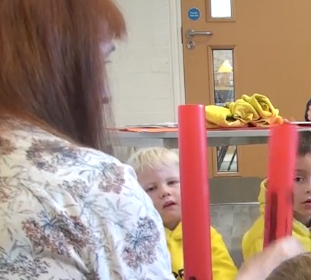Dinosaurs Level: Key Stage 1 - Introductory
Music Lesson Description
High and Low Pitch
After I'd used the word, pitch with the children several times, I was thrilled to hear India use the term spontaneously to comment on the tune of a song we were singing. Introducing the right vocabulary in context really does promote understanding. I took the opportunity to explore with the children the physical properties of pitch in relation to the xylophone, and left it out so that they could experiment individually after the lesson.
Which dinosaur would make the lowest pitch sound and which would make the highest pitch sound? Bigger things and longer things generally make the lowest sounds and the children can test this out in different contexts, for example using the piano strings or even different sized saucepans that are made of the same material. Boomwhackers are good fun too - they are tuned to specific pitches, just like chime bars.

In my set, the short red one is higher C and the long red one is lower C. It can be a bit confusing at first because the tallest boomwhacker makes the lowest sound and, at first, children can confuse 'tall' (height) with 'high' (pitch)!

Here's an activity that any teacher could do, using a set of chime bars or a big xylophone. It helps the children to understand high and low pitch. Children need plenty of reinforcement about the meaning of high and low pitch as opposed to high and low volume (dynamics) so it's best to be consistent when you use the words loud and quiet for dynamics and high and low for pitch.





